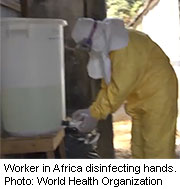
TUESDAY, Sept. 16, 2014 (HealthDay News) — On the same day that President Barack Obama was to announce a significant increase in U.S. aid to help combat West Africa’s Ebola crisis, the World Health Organization warned Tuesday that the window to contain the deadly virus was closing and infections could start doubling every three weeks.
Obama is expected to dispatch 3,000 military personnel to West Africa to offer medical and logistical support to beleaguered health care facilities in Guinea, Liberia and Sierra Leone, and to increase the number of beds to quarantine and treat victims of the epidemic that has already claimed more than 2,200 lives.
The program’s goals include the training of as many as 500 health care workers a week, and building as many as 17 health care facilities with 100 beds a piece. Home health care kits will be distributed, and local residents will be trained on how to handle people infected with the disease, USA Today reported.
The total cost of the aid program is estimated at $763 million, the newspaper said, including $175 million that the United States has already set aside to fight Ebola, which can have a mortality rate as high as 90 percent.
Administration officials said it would take about two weeks to get the U.S. personnel on the ground in Africa, the Associated Press reported. American troops will coordinate the aid effort through a joint command center in Monrovia, Liberia, where the majority of deaths have occurred, USA Today said.
Underscoring the nature of the threat, the World Health Organization (WHO) said Tuesday that nearly $1 billion is needed for everything from paying health workers and buying supplies to tracing people who have been exposed to the virus. An estimated $24 million is needed just to pay for burials and body bags to contain the infectious disease. Also needed: protection suits, especially for health care workers who are at heightened risk because Ebola is spread through contact with bodily fluids such as blood from a patient.
It’s estimated that approximately 5,000 people have been infected with Ebola in West Africa. WHO projections say that number could rise to as high as 20,000 people.
White House officials said it’s crucial to contain the Ebola as swiftly as possible. Some U.S. medical experts worry that the virus could mutate and expand beyond Africa, possibly threatening the United States, The New York Times reported.
Dr. William Schaffner, an infectious disease expert at Vanderbilt University in Nashville, endorsed Obama’s plan, labeling it a “major commitment,” the Times reported.
“It seems coordinated and coherent,” he told the newspaper. The “real core,” he added, was the military’s logistical support “because the heart of any kind of epidemic containment concept is getting the goods to the right place, putting up the institution.”
Michael Osterholm, director of the University of Minnesota Center for Infectious Disease Research and Policy, told the Times that Obama’s plan didn’t go far enough. The focus on Liberia was too limited, and more should be done to assist Guinea and Sierra Leone, he said.
“We should see all of West Africa now as one big outbreak,” Osterholm said. “It’s very clear we have to deal with all the areas with Ebola. If the U.S. is not able or not going to do it, that’s all the more reason to say the rest of the world has to do it.”
Four American medical aid workers have been infected with Ebola while working in West Africa. Two — Dr. Kent Brantly and Nancy Writebol — have recovered after aggressive treatment at Emory University Hospital in Atlanta.
The third health care worker, Dr. Rick Sacra, continues his recovery at Nebraska Medical Center in Omaha.
The fourth infected American, so far unidentified, continues to undergo treatment at Emory.
Dr. Tom Frieden, director of the U.S. Centers for Disease Control and Prevention, said Ebola is primarily being spread in West Africa in two ways: The first is among people caring for people with the disease, whether at home or in health-care settings and hospitals; the second is unsafe burial practices.
More information
For more on Ebola, visit the U.S. Centers for Disease Control and Prevention.
Copyright © 2025 HealthDay. All rights reserved.

